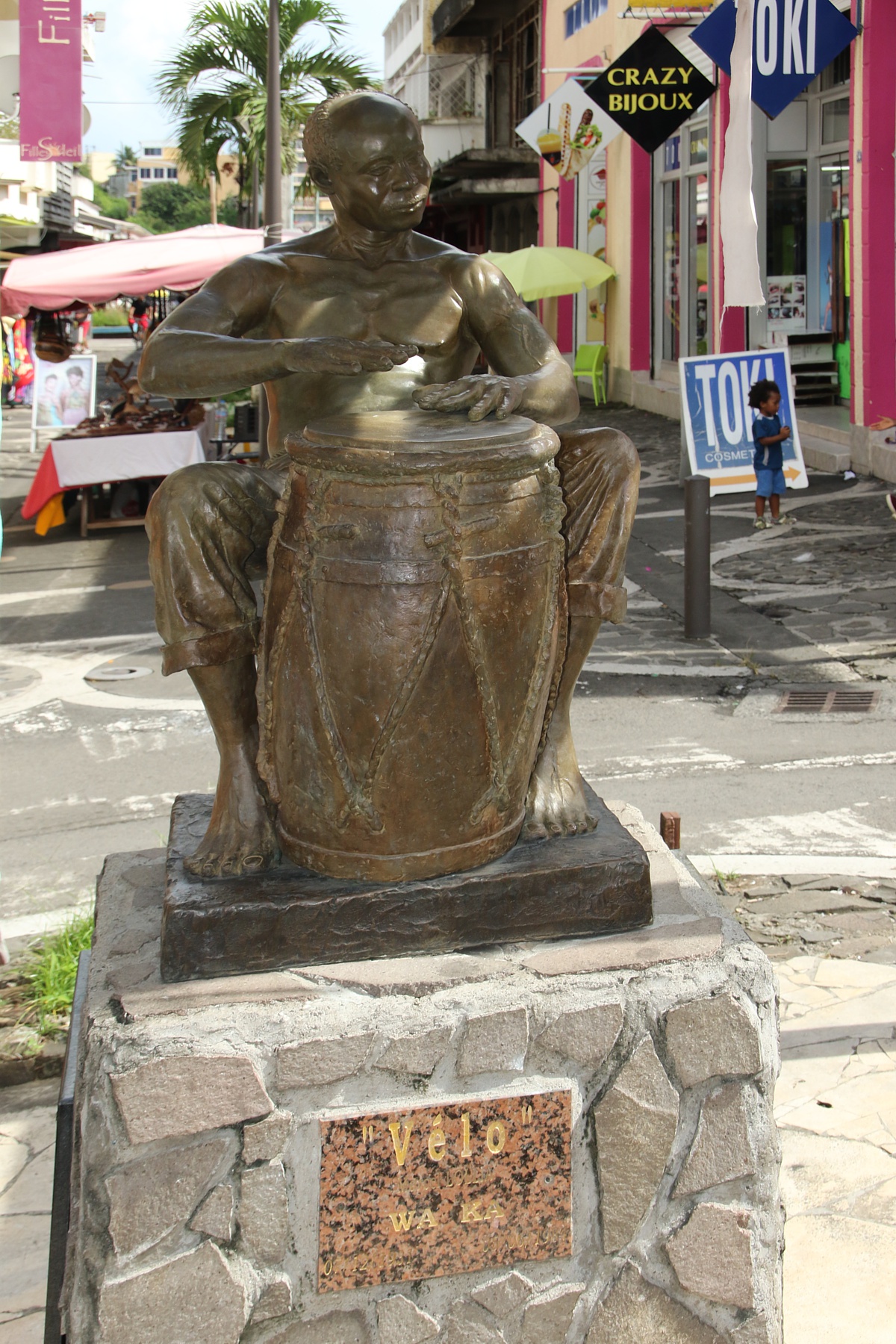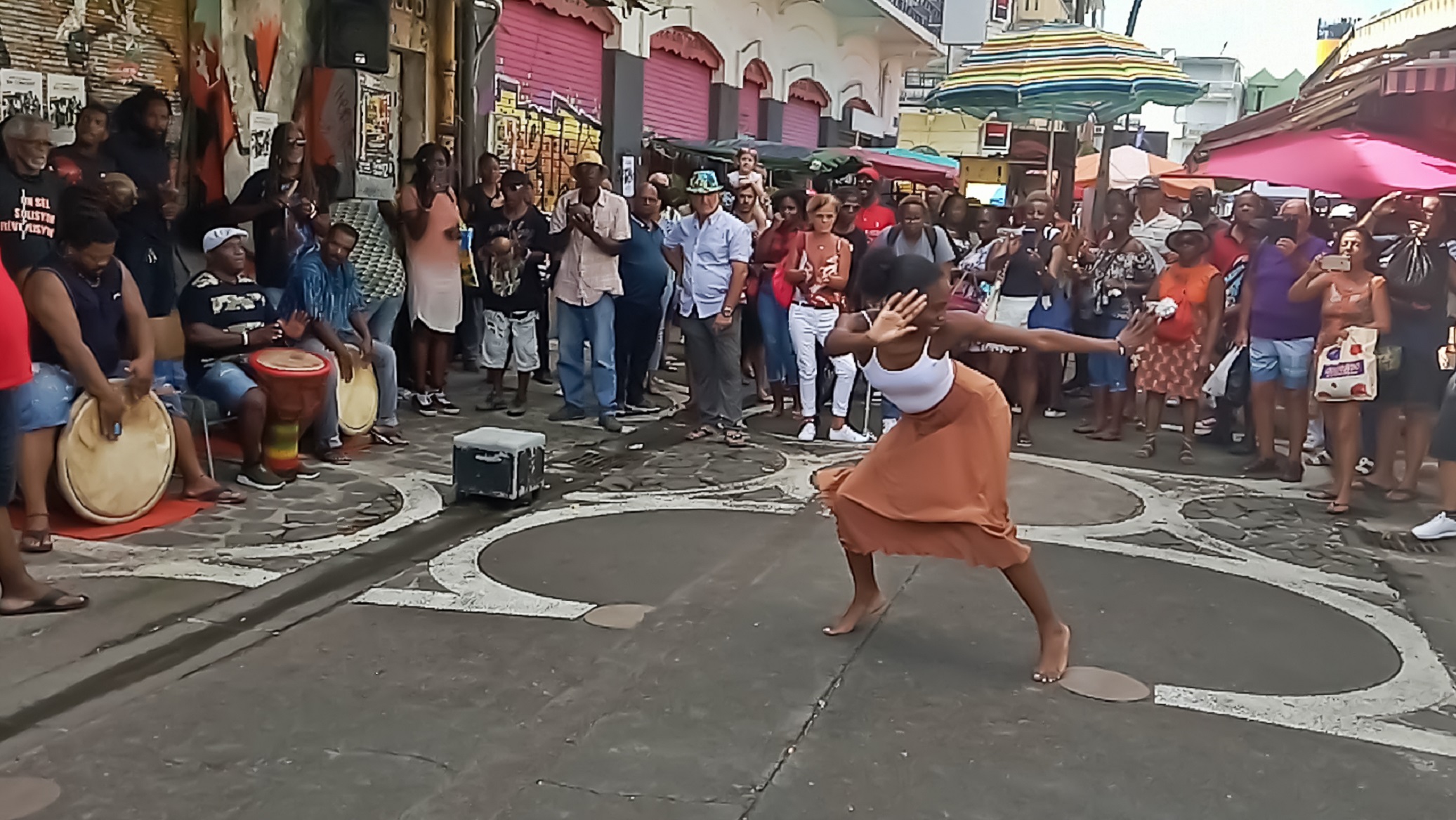Gwoka: music, song, dance and cultural practice representative of Guadeloupean identity
A celebration of humanity
Guadeloupe is a French colonial island located in the Caribbean sea, where Gwoka holds its roots. This archipelago of the Lesser Antilles consists of 6 inhabited islands. Basse-Terre, Grande-Terre, Marie-Galante, La Désirade, and Les Saintes (Terre de Haut and Terre de Bas). Today, Gwoka is practised wherever Guadeloupeans live, and particularly in the Paris region and France’s major college cities. Previously a slave island, the isle is now mostly populated by African slave descendants. Deported and enslaved in Guadeloupe from the eighteenth century, they introduced the components of today’s Gwoka. Now recognized as a flagship element of Guadeloupean identity, it combines the responsorial singing in Guadeloupean Creole, the rhythms played on the Ka drums (“makè” and “boula”), “chacha” and “tibwa”, and dance.
Gwoka performance

In its traditional form, Gwoka unites these three areas of expression by accentuating the individual qualities of improvisation. The solo singer aims at conveying emotion (“lokans” in Creole), with a solo dancer (always alone in the space). The singer tries to establish a creativity and quality of the dialogue with the solo drum (a “makè”) who plays the Ka drum. This “makè” emphasizes the dancer’s steps but also has its own creativity.
The other drummers (called “boularyen”), play standardized rhythms, including “léwoz”, “menndé”, “kaladja”, “toumblak”, “padjanbel”, “woulé”, “graj”. Among these rhythms, the “léwòz” is the preferred space of expression of Gwoka. During night shows, it brings all the participants together, including the public, in a circle called “lawonn”, and its center, left free, welcomes the dancers. It really functions as a place to develop individual talents. The public clap their hands and sing the chorus led by the soloist. One by one, they enter the dance, performed facing the drums. The “léwòz” is open to all, regardless of one’s age.
Nowadays, Gwoka tends to mix-up with contemporary music styles. And explores new avenues of music, choreography or singing, namely with “techni’ka” (inspired from techno music), “Gwoka modèn”, and “Gwoka jazz”.

A resistance gathering for an origin
The Africans deported and enslaved in Guadeloupe from the seventeenth century introduced the components of today’s Gwoka. Defying the Black Code, they used to gather to play drums, to sing and dance. Through this, they made Gwoka a space of resistance to dehumanization and acculturation, laying the foundations for the tradition’s viability. Until the 1950s, Gwoka’s participants were mainly small farmers. In the 1960s, the anti-assimilation and anti-colonial movements started to protect and raise awareness on Gwoka’s tradition. Certainly, these movements laid the ground for a continuous conservation work over the next decades.
From the 1970s, by including Gwoka in most of their demonstrations, the new leaders of the identity and nationalist movement, including many intellectuals, students and secondary school pupils, aroused a passion for this expression. They encouraged the gradual spread of the practice of Gwoka to the Guadeloupean population. In the 1980s, the newly-created schools and associations were henceforth mainly responsible for the transmission of the art.
From family transmission to general instruction
Initially, transmission mainly occurred through assimilation within families and closed knowledge groups. This informal transmission continues today in the family lineage of some “Maître-Kas” (1950’s musicians, greatly admired in Guadeloupe), and in friend groups.

In general, nowadays, music and dance are transmitted through cultural associations and Carnival groups. Transmission also takes place through records and their broadcast on the radio. Becoming increasingly formal, transmission often occurs in schools of traditional dance and music or in public educational establishments. Gwoka dance and music is, notably, included in the curriculum of Regional Language and Culture classes. Printed and audio-visual guides have also been created to help beginners to learn the Ka drum. Particularly children and young people.
Gwoka also has a strong craftsmanship side, with the skills related to building the Ka drum. These skills also used to be transmitted from older generations to new ones, by observing the choices to chose materials and produce the Ka drum and other Gwoka instruments. These days, transmission mostly occurs through professional craftsmen teaching apprentices directly in their workshops. Increasingly, this know-how is constantly encouraged and enhanced by new research and testing.

A crucial importance to local Creole’s
Gwoka is one of the most structuring elements of the Guadeloupean society. It enhances the feeling of identity and provides a sentiment of communal development and individual pride. Gwoka is present at the important points of daily life and, as such, it plays an important role in structuring time in Guadeloupe. It is there at festive, cultural and secular events.
For instance, and although Gwoka doesn’t have an established religious function, the tradition is present as a part of funerals in most families. It joins the “Nyabinghi” for some of Guadeloupe’s Rastafarian rituals, and some artists credit its use during such an event to a spiritual dimension. Another time when Gwoka is present is at Christmas, in the rhythmic basis of the carols. Gwoka’s “menndé” rhythm also underlies the poly-rhythms of Carnival’s percussion. At last, it also accompanies movements of social and political protest.

It’s also worth mentioning that Gowka is so important in Guadeloupe that several thousand people regularly practice it every week in Gwoka schools and associations.
Young children’s attraction to Gwoka makes this an endless resource for education. Thus, educational approaches for the development of learning methods rely on Gwoka. In the field of sport, Gwoka music integrates the practice of some indoor disciplines. Such as martial arts and fitness. Other studies explore the therapeutic functions of Gwoka. Specialist educators and psychotherapists use Gwoka as an intermediary to promote the integration of those in need.
A protection well deserved…
In 2014, Gwoka’s tradition was named for the UNESCO’s Representative List of the Intangible Cultural Heritage of Humanity. With a peculiar detail that shows how well-fitted the tradition is for the list. It matched all of the “worth protecting” categories set by the UNESCO at once ! Indeed, Gwoka is an “oral tradition and expression, including language as a vehicle of the intangible cultural heritage”. But also an “art perfomance”, a “social practice, a ritual and a festive event”, and the craftsmanship of the instruments corresponds to the “knowledge and practices concerning nature and the universe” and the “traditional craftsmanship” categories.

In the past, after opposing the dehumanization of slaves deported from Africa, Gwoka namely contributed to awareness of Guadeloupeans’ political and cultural rights. In a more recent way, today’s Gwoka conveys the values of ethics, conviviality, resistance, respect and dignity.
Representative of cultural identity, Gwoka is also important and worth protecting because it’s a factor of cohesion in Guadeloupean society in all its ethnic and cultural dimension. Indeed, Gwoka conveys the values of living together. For instance, its practice helps to integrate new residents into Guadeloupe.
Gwoka and the Human Rights…
On a human level, Gwoka encourages the protection of human dignity and to make humanity come together in the respect and recognition of basic human rights, in particular the Creole’s cultural rights. As a consequence, one of the objectives of Gwoka Festivals is, through exchanges, to contribute to the development of cultural cooperation with the Caribbean and the world. This objective is based on the values of humanity and universalism that are inherent to Gwoka.
For example, “Lawonn of léwoz”, one of the biggest Gwoka festivals in the world, is a special space for the expression of Gwoka. It welcomes all the participants and actors of Gwoka in a relationship of exchange. It allows each person to express themselves, whilst preserving individuality. In the past, it allowed ancestors of different ethnic groups and cultures to go beyond the divisions in slave society to establish a new community and to share and dialogue in Guadeloupe.
By drawing attention to this practice of culture and identity, the whole diversity and the richness of the cultures of minorities are celebrated. In the context of globalization, where these cultures are sometimes threatened, Gwoka’s enlistment in this UNESCO program is the opportunity to recall their contribution to cultural diversity and to human creativity.
…But that locals didn’t wait for !
However, a lot of safeguarding measures are already in place in Guadeloupe, to make sure that this tradition perpetuates.
Firstly, it’s worth noting that more than 150 Gwoka associations exist in Guadeloupe and in Metropolitan France. In Guadeloupe, some have up to 600 members and are in charge of Gwoka schools and carnival groups of more than 400 members. These associations are henceforth the main organizers of the léwoz (Gwoka festivals). Which happen every weekend across the territory.

On the academic level, research and therefore publications about Gwoka have constantly increased since the 1980s. The first essays of historiography are now joined by about fifteen documentary videos, around ten printed or audio-visual guides and ten scientific publications. About fifteen university research projects are supported or are in progress in French and in foreign universities, with two of them supported by physicists at the University of the French West Indies and Guiana.
Additionally, on the international level, Gwoka shines. The Guadeloupeans set up associations in major European cities. Which help to share with other communities the values which Gwoka conveys. They organize events and often invited to cultural festivals.
Resume
Deported and enslaved in Guadeloupe from the eighteenth century, African slaves introduced the components of today’s Gwoka. This art combines the responsorial singing in Guadeloupean Creole, the rhythms played on the Ka drums, and dance. The Africans deported and enslaved in Guadeloupe from the seventeenth century introduced the components of today’s Gwoka. Defying the Black Code, they used to gather to play drums, to sing and dance. Through this, they made Gwoka a space of resistance to dehumanization and acculturation, laying the foundations for the tradition’s viability. Gwoka is one of the most structuring elements of the Guadeloupean society. It enhances the feeling of identity and provides a sentiment of communal development and individual pride.
